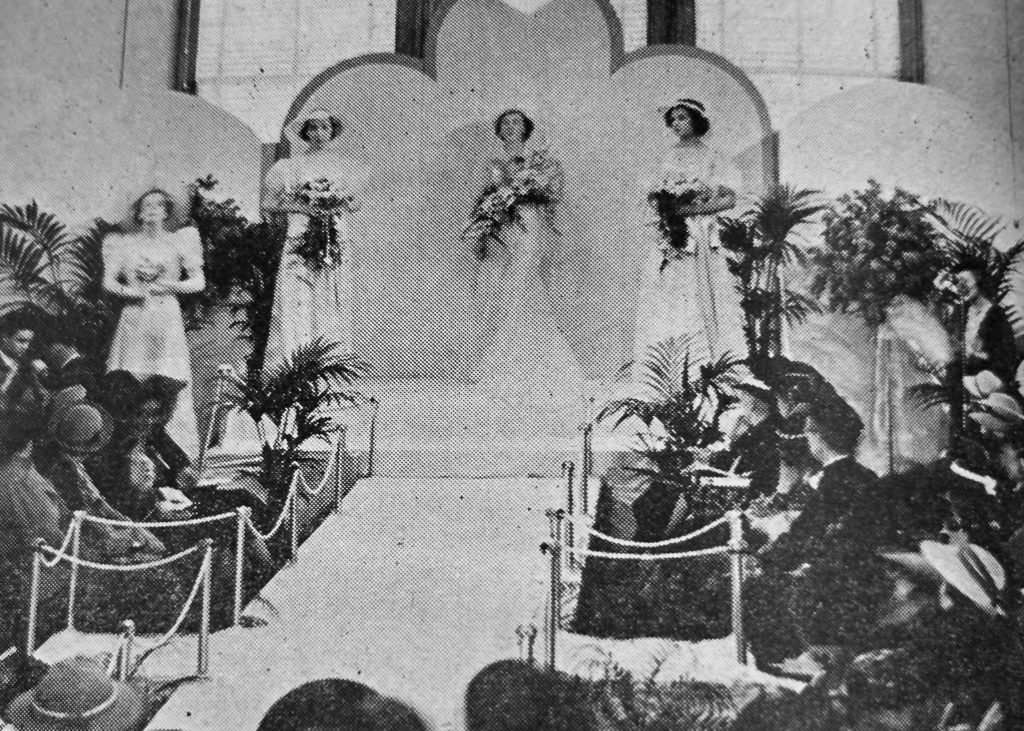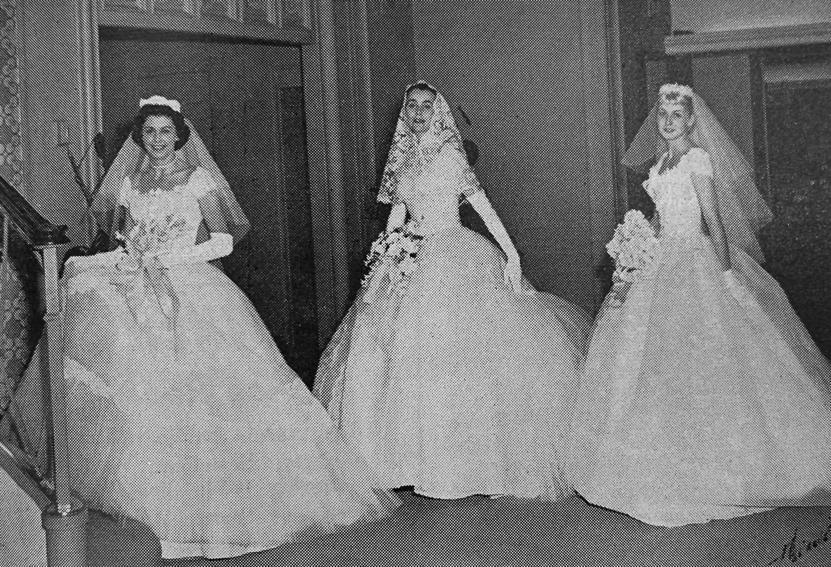The third floor of Emery, Bird, Thayer was the site for a May 1937 fashion show featuring everything from beach togs to gardening overalls to bridal dresses, as they were termed. In charge was Murrel “Muriel” Finley Groves (Mrs. R. Dinwiddie Groves), herself a recent bride – and quite possibly the only former Ziegfeld Follies performer in the room. (If you can prove us wrong, we’ll be delighted.) As our scribe noted, “A raised platform, decorated with great bouquets of lilacs, supplied stepping space for the models, who included such pretty society girls as Katherine Dickey, Josephine Jobes, Suzanne Callaway, Nancy Jane Redheffer, Virginia Punton, Mary Joe Marshall, and Mrs. Clifford Johnston. As a finale to the bridal tableau, Mrs. Johnston sang ‘All For You’ very beautifully accompanied by the orchestra.” Orchestra? Well, yes. The event was designed to appeal to as many senses as possible.
The golden age of bridal fashion shows seems to have been from roughly the mid-1930s until the 1970s. In New York in April 1936, a show for stylists featured a parade of “brides of two centuries” – and the tip that the hot new color would be “azalea pink.” (Did that catch on at the time? Alas, most of the wedding photos we’ve seen from that era are in black and white.)

A glimpse of the Wedding Tableaux presented by Emery, Bird, Thayer’s at their Summer Fashion Showing this week. Reprinted from the May 8, 1937 issue of The Independent.
Although wedding season is often thought of as spring to early fall, the shows were held at all times of the year. John Taylor’s held one in November 1947 that was directed by Kathleen Blackburn, a bridal consultant at Macy’s in New York. It was intended to address the topic of fall and winter weddings. Among the styles was a gown that reflected Victorian influences. It featured padded hips, a bouffant bustle, and a long train. Why? All the better to show off the bride’s tiny waist. More modern was a silver white satin gown, with accents of blue on the veil and in the bridal bouquet. This was paired with blue satin shoes. Brides wishing to change into going-away attire could choose from an array of suits, among them one of champagne satin with black braid trim and a brown orchid corsage. The bridesmaids’ attire included crinolines and hoop skirts, and, for holiday-themed weddings, green velvet and mistletoe. Among the models were a pair of three-year-old twins, who were flower girls in peach taffeta.
At Emery, Bird, Thayer’s February 1950 show, the new trend that was heralded was the floor-length wedding dress, but much attention was given to items meant to delight the groom. As the Kansas City Star stated, “Negligee ensembles were lavish with lace, nylon in permanent pleats, embroidery work and other lovely accents. One embroidered nylon gown and negligee set had a delicate touch of baby blue ribbon in beading at the waist. A mauve negligee in pure silk chiffon is the type long treasured by brides in their trousseaux.” (We pause now to try and remember when we last heard anyone mention a trousseau. It may have been before some of our younger colleagues were born.)
Not all bridal fashion shows were advertisements for stores. We wish we had had a ringside seat for one held at a tea given by members of the Sketch Box committee in May 1954. Members modeled their own wedding gowns. Adding to the fun, they showed their silver. (Francis I? Eloquence? Damask Rose? Spring Glory? We wish we knew.)
As time went on, there was a greater emphasis on in-store gift registries, which might feature silver, china, crystal, linens, and housewares – and even bridal consultants, who kept track of all the lists. In October 1959, Dorothy Cassidy, the managing editor of Bride and Home magazine, came to Our Town to interview Edythe Moore, the bridal consultant at Halls. As our scribe noted, “Halls bridal registry was selected by the magazine to exemplify this advisory service to the bride, helping with the coordination of her table setting, decorative accessories and the many facets of her wedding and launching of her new home.”
For some stores, an occasional event wasn’t enough. In 1965, Macy’s devoted a week to brides-to-be. As Thomas W. Johnston, the president, recounted in an ad, “The week was climaxed with a beautiful Bridal Fashion Show that included a showing of unusual bridal bouquets created especially for the show.”

The age-old tradition of lovers on St. Valentine’s Day was saluted last week at Woolf Brothers. A bridal tea was held on the store’s third floor where the sentimental atmosphere of Cupids, nosegays of Sweetheart roses and hyacinths was the backdrop for the lovely Brides’ Parade. Many three-generation groups were in the applauding gallery. A trio of models are pictured: Mrs. W. W. Humphrey, Jr., Mrs. William Smith, and Nancy Hamlin, daughter of the Ford A. Hamlins. Reprinted from the February 25, 1956 issue of The Independent.
The events at department stores remained popular into the 1970s. January and February 1972 saw shows at Harzfeld’s, Swanson’s, Woolf Brothers, and The Jones Store. Notably, though, there was already a shift to more individualistic thinking. (This will come as no surprise to anyone who remembers the “Me Decade.”). The event at Harzfeld’s was narrated by Lynn Scott Miller of Mademoiselle magazine. Barbara Jaekel caught the mood of it in her summary for the Kansas City Star: “Tuck your hair into a beaded skull cap or wear it long beneath a wide-brimmed picture hat… Gown your bridesmaids in seersucker… or gingham or tattersall checks.”
As long as there are brides and grooms, there will be fashion shows featuring wedding finery and gift registries. Most of the department stores that were here 50 years ago are now merely memories. As the grandchildren and great-grandchildren of the brides-to-be who were in the audience of that May 1937 show at Emery, Bird, Thayer prepare for their own weddings, they may visit bridal boutiques, or wedding expos at convention centers and hotels, or simply click through as many options online as they care to view. What they’ll have in common with earlier generations, we hope, is joy and excitement as they await The Big Day – and all the days to come.
Featured in the July 8, 2023 issue of The Independent.
By Heather N. Paxton